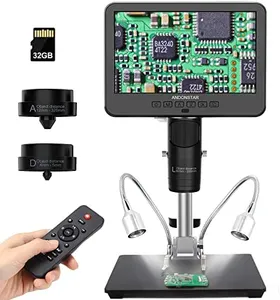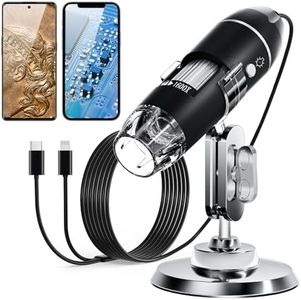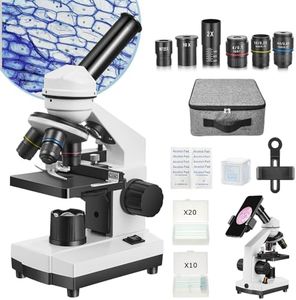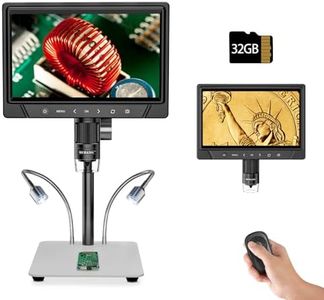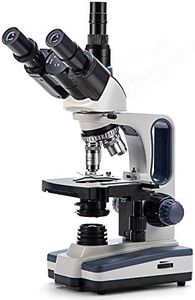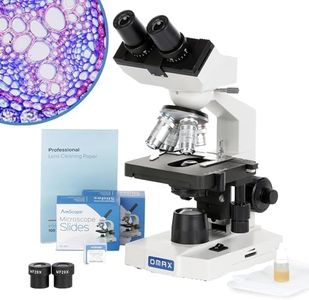10 Best Microscopes 2025 in Canada
Our technology thoroughly searches through the online shopping world, reviewing hundreds of sites. We then process and analyze this information, updating in real-time to bring you the latest top-rated products. This way, you always get the best and most current options available.

Our Top Picks
Winner
100X-2000X Microscopes for Kids Students Adults, Powerful Biological Microscopes for School Laboratory Home Education,with Microscope Slides Set, Phone Adapter
This biological microscope is a solid choice for students, kids, and beginners interested in exploring the microscopic world. It offers a wide magnification range from 100X up to 2000X, covering multiple levels through a combination of a WF25X eyepiece, a 2X lens, and four objective lenses (4x, 10x, 40x). This variety lets users zoom in on many different sample types, which is great for both simple and more detailed observations. Its monocular design means you look through a single eyepiece, making it easier to use for beginners. The dual LED lighting system, with lights from both the top and bottom, helps illuminate samples clearly, and the inclusion of a condenser with diaphragm improves image clarity and color accuracy.
The focusing mechanism includes both coarse and fine adjustments, which helps achieve sharper, more precise images. The metal frame gives the microscope a sturdy feel, adding to its durability. It comes with useful extras like a phone adapter for capturing images, a Bluetooth shutter, and a set of 28 prepared slides, which makes it ready to use right out of the box. The microscope does not mention advanced stage controls for moving slides smoothly, which might limit easy sample manipulation for more detailed work. Also, while monocular microscopes are simpler, binocular designs are generally more comfortable for extended use.
Weighing 1.65 kg, it is portable enough for home or school settings but may not be ideal for very young children to carry on their own. This microscope is well suited for home education, school labs, and hobbyists looking for a versatile, beginner-friendly tool that balances good magnification and decent image quality with practical accessories.
Andonstar AD246S-M HDMI Digital Microscope 2000x for Adults, 3 Lens 2160P UHD Video Record, 7 Inch LCD Soldering Microscope, Coin Microscope, Biological Microscope Kit, Windows Compatible
The Andonstar AD246S-M is a versatile digital microscope designed for adults and advanced hobbyists who want a multi-purpose tool for tasks like soldering, coin collecting, and biological observation. It offers a wide magnification range from 18x up to over 2000x using three interchangeable achromatic lenses, covering a broad spectrum of close-up work and fine detail viewing. The built-in 7-inch LCD screen with UHD 2160P resolution and HDMI output helps users view clear, sharp images without straining their eyes, which is a big plus compared to standard eyepieces.
Its LED lighting with eight adjustable brightness levels ensures good illumination across various sample types, and the sturdy metal stand provides stable support, especially important for delicate tasks like circuit board repair. Focusing is straightforward with a rotary wheel, and the adjustable bracket makes positioning easy. The inclusion of measurement software compatible with Windows adds a professional touch, allowing precise size and area measurements.
Some drawbacks include the absence of traditional eyepieces, which might feel less natural to users familiar with optical microscopes. The device is relatively bulky and heavier (around 2.25 kg), so it’s less portable if you need to move frequently. Also, it’s primarily designed for use with digital screens rather than direct viewing through an eyepiece, which may not appeal to everyone. This microscope kit comes well-equipped with useful accessories like prepared slides, a remote control, and a micro SD card for image and video capture, making it ideal for educational purposes, hobbyists, and professionals needing detailed inspection and documentation. It fits best those who want a digital, multi-use microscope with strong magnification and video capabilities rather than a traditional optical-only model.
SWIFT SW380T 40X-2500X,Trinocular Compound Lab Microscope with Double Layer Mechanical Stage,Siedentopf Head, Wide-Field 10X/25X Eyepieces
The SWIFT SW380T is a versatile trinocular compound microscope designed for students, clinicians, and hobbyists who want to explore tiny specimen details with high clarity. It offers a broad magnification range from 40X up to 2500X, allowing users to examine everything from basic cells to very fine structures, which suits a variety of educational and professional uses. The microscope uses achromatic objectives, which help reduce color distortions for clearer images. Its LED lighting provides bright and even illumination for viewing slides, enhancing visibility without generating much heat.
The double-layer mechanical stage allows precise slide positioning, making it easier to scan specimens smoothly, while the ultra-precise coarse and fine focus knobs help achieve sharp focus quickly and accurately. The wide-field eyepieces (10X and 25X) with an ergonomic 30-degree tilt and adjustable interpupillary distance aid in comfortable, strain-free viewing during extended use. The Siedentopf head rotates fully, facilitating shared use without disturbing focus. Weighing 4.3 kg and made from sturdy metal, it’s durable but not very portable. It operates on standard 110V power.
While the high maximum magnification is excellent for detail, it may require some practice to handle effectively, especially for beginners. The product is not discontinued and comes with a reassuring 5-year warranty. This microscope is a solid choice for those who need reliable, sharp imaging with versatile magnification and ergonomic features for prolonged study or clinical tasks.

